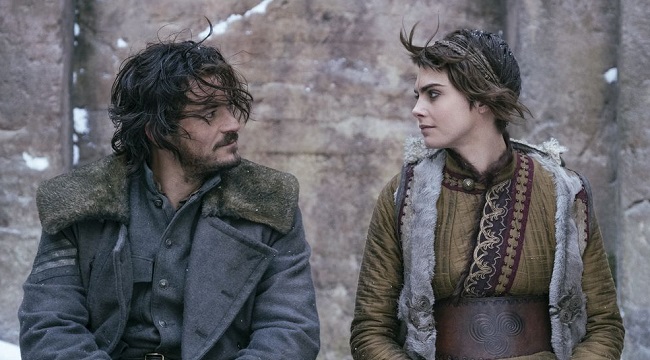
Judging by the series’ first trailer and first few episodes, most audiences will come away from Amazon’s Carnival Row thinking that they’re watching a fantastical version of a neo-noir story like Chinatown. (Blade Runner for people who prefer J. R. R. Tolkien over Philip K. Dick.) And they’re not wrong. Co-creator Travis Beacham adapted the show from his own unproduced film script, A Killing on Carnival Row — the title of which sounds like something taken straight out of the noir genre playbook. But when viewers make it to the third episode, however, this particular mashup flies out the window and crashes violently onto the street below.
That’s because Carnival Row, which is the brainchild of Beacham and René Echevarria (and, at one point, a Guillermo del Toro production), then decides to use an entire episode as a flashback to Rycroft Philostrate (Orlando Bloom) and Vignette Stonemoss’ (Cara Delevingne) first meeting during a World War I-esque conflict. There’s nothing inherently wrong with doing such a thing, of course, as plenty of other shows have used a similar tactic. But in our current age of streaming, it simultaneously feels convoluted and unnecessary. What could have been a mere series of short flashes in a more forthright, understandble episode instead becomes another entry in an eight-hour movie.
So, what’s Carnival Row about? A lot of things. The primary story follows Bloom’s Philo, a police inspector, and Delevingne’s Vignette in the rough-and-tumble, London-like city known as “The Burgue.” The cosmopolitan city has become the center point for a burgeoning multicultural society whose members include humans, the fairy-like fae, the horned faun, trolls, centaurs, goblins, and many others. And like any big cultural meeting place whose inhabitants are still recovering from the horrors of war, everyone doesn’t always get along. Hence Philo’s investigation of a string of violent attacks against nonhuman women.
Bloom’s character bears all the hallmarks of a neo-noir anti-hero. He’s a policeman who seems to be on speaking terms with just about anyone who isn’t also a cop, stands up for the weak, and accomplishes this by performing many not-entirely-legal tasks. As for Delevingne’s fae Vignette, she is the obvious femme fatale and, on numerous occasions throughout the series, exhibits most of the tropes associated with such an archetype. The two share a past though Vignette thinks Philo is long since dead. When she discovers this to be untrue after finding herself in Burgue after escaping her war-torn homelands, Vignette endeavors to confront Philo.
This, in and of itself, is an oft-told story that, in the context of Carnival Row, has been beautifully decorated with heavy doses of fantasy and steampunk storytelling and imagery. For this, Beacham and Echevarria deserve plenty of acclaim, as Philo and Vignette’s otherwise simple narrative allows the pair to expertly perform the much-needed task of world-building. The series contains plenty of easily recognizable elements, yes, but it’s not based on any particular tale that audiences will already know. It’s a wholly original creation, set in a world that exists in no other medium. For that reason, world-building needs to happen in order to get the audience on the same page, and Beacham and Echevarria achieve precisely this.
What plagues Carnival Row, then, are those story and character elements that try to extend its reach too far beyond the primary whodunnit that features Bloom and Delevingne. That’s not to say that a show as purposefully expansive as this cannot delve into B and C plots with other leading and supporting characters, of course. But such efforts take a good foundation and lots of time. Carnival Row aims for the former with all its world-building efforts, and this is the only reason the Game of Thrones-esque political plottings of the government’s opposition party and the chancellor (Jared Harris) barely survive. The same goes for the more social aspects of the Spurnrose siblings (Tamzin Merchant and Andrew Gower), whose “polite society” wants nothing to do with their new nonhuman neighbors.
As for the latter method of time, Carnival Row cannot possibly achieve the complexity of Thrones (or any other similarly intricate serialized story) without enough episodes and seasons. Yes, Amazon has already renewed it for a second season before the first is out, so the showrunners will have plenty of time to expand upon the seeds they tried to plant the first time around. Unfortunately, not all of this season’s plantings are strong enough to take root.
So, what it all boils down to is this: Carnival Row is a neo-noir fairy tale infused with elements of the steampunk genre. But it’s also a war story — a morality tale with blatantly obvious ties to contemporary geopolitics and immigration controversies — with power struggles meant to mirror those of programs like Thrones and House of Cards, and so many other genres and subgenres. As a result, the eight episodes that constitute Carnival Row‘s first season feel more overstuffed and overcooked than not. So, instead of being an appetizing starter for Amazon Prime subscribers who are itching for the upcoming Lord of the Rings series, the series is more or less a stomach-churning meat pie.
Though, to be fair, sometimes the worst pot pies can still manage to feature at least one or two still-identifiable (and somewhat tasty) ingredients.
‘Carnival Row’ begins streaming Friday, August 30th on Amazon Prime.






